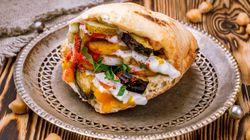Parents who manage meals at home are always in need of fast, flavourful and functional recipes. But when it comes to food, it’s not a one-size-fits-all sort of deal ― speed, flavour and function are relative to the various stages of parenthood. Mums and dads of toddlers, for example, have very different schedules and meal requirements from parents of tweens and teens.
Coming up with new ideas for quick, tasty food for the family is always top of mind for most parents and caregivers, but that doesn’t necessarily mean everyone’s mastered it.
We gathered tips, tricks and recipe suggestions from parents of children of all ages ― and those parents also happen to be culinary pros. Check out their advice that all parents can use to get a nutritious dinner on the table, no matter how much downtime you do or don’t have.
For parents of toddlers: Focus on development and distraction
If you’ve got children under the age of 3, you should nurture not only their growing bodies but their developing taste buds, as well.
Dr. Teresa Purzner, co-founder ofCerebelly and the mother of three children (ages 2,4 and 6), cautions, ”The first two years of life are critical for brain development. During this period, each region of the brain requires its own set of nutrients to grow optimally.” By the time children reach their first birthday, Purzner advises it’s time to “think more seriously about protein and iron and introduce lean meats, fish, chicken and beans.”
In order to realistically get said nourishing meals on the table, focus on the ingredients while your kids focus on something else. Daphne Oz, cohost of Fox’s “MasterChef Junior,” nutrition ambassador for Persona Nutrition and mother of four children (ages 1, 2, 4 and 6), told HuffPost, “You’ve got to keep them distracted otherwise you’ll never get anything done in the kitchen.” Oz, who has “maybe 30 minutes at night for active cooking,” relies on kid-friendly but grown-up recipes that she “can set and forget and cook passively while taking care of other things.”
Her Nutty Chicken Fingers recipe provides the protein enrichment and the textural variety young eaters need and a flavourful crunch the adults will appreciate.

Nutty Chicken Fingers with Honey-Mustard Barbecue Dip
Chicken fingers
- 1 teaspoon sweet paprika
- 1 teaspoon garlic powder
- 2 teaspoons kosher salt
- Freshly cracked black pepper
- Four 6- to 8-ounce boneless, skinless chicken breasts, cut crosswise into 1-inch-thick strips
- 1/3 cup blanched almonds
- 1/4 cup pumpkin seeds (pepitas)
- 3 tablespoons sesame seeds
- 2 large eggs
- 1 tablespoon soy sauce
- 4 tablespoons extra-virgin olive oil
1. In a medium bowl, whisk together the paprika, garlic powder, 1 teaspoon of the salt and pepper to taste. Add the chicken strips and turn to coat them in the spices.
2. In a blender, pulse the almonds 5 times. Add the pumpkin seeds and sesame seeds and pulse until the mixture is semi-fine. Transfer the mixture to a medium bowl.
3. Whisk the eggs and soy sauce in a small bowl, then pour over the chicken. Turn the chicken to coat, then dredge each piece through the almond mixture, be sure to coat all sides.
4. In a large nonstick skillet, heat 2 tablespoons of the olive oil over medium-high heat. Add about half of the chicken pieces, spreading them out evenly, then reduce the heat to medium. Cook without moving the chicken until it’s browned, about 3 minutes, then carefully turn it over and brown on the other sides, 2 to 3 minutes longer to cook through. Transfer the chicken to a paper-towel-lined plate. Add the remaining 2 tablespoons oil to the skillet and cook the remaining chicken. Serve the chicken with the sauce on the side.
Honey Mustard Barbecue dip
- 1/4 cup mayonnaise
- 2 tablespoons barbecue sauce
- 1 tablespoon Dijon mustard
- 1 tablespoon honey
- 1/4 teaspoon kosher salt
1. In a small bowl, whisk the mayonnaise, barbecue sauce, mustard, honey, and salt.
Pre-teens need nutrients. Just don’t make them noticeable.
Older kids who are approaching their teens need major fuel, so it’s important to feed them meals with fruits and vegetables that still feel fun. At this age, “they are really active and growing like crazy,” said Katie Chin, executive chef and founder of Wok Star Inc. She works hard to make sure her 12-year-old twin daughters “get a balance of lean protein, whole grains and veggies.” Chin relies on one-pot recipes like herChicken Fried Rice,” in which “you can throw in any leftover protein and veggies.”
Putting fruits, veggies and lean protein all on the same plate is how Catherine McCord, Food Network regular and founder of weelicious.com, keeps things fun and flavourful for her 11- and 13-year-old kids (she also a 5-year-old). Her Salmon with Summer Fruit Salad recipe is a staple she turns to that takes under 30 minutes to make.

Salmon with Summer Fruit Salad
- 1 1/2 pounds salmon filet
- Kosher salt
- Black pepper, optional
- 1 avocado, chopped
- 1/2 cup strawberries, halved
- 1 ear of corn, cut off the cob
- 1/2 cup cherry tomatoes, halved
- 2 tablespoons chopped coriander
- 1 peach, diced
- 1 small lime, juiced
1. Preheat broiler. Place salmon on a foil lined baking sheet, season with salt and pepper and broil 8-10 minutes or until golden.
2. In the meantime, place the remaining ingredients in a medium sized bowl and toss to combine. Season with a pinch of salt.
3. Place the salmon on a plate or platter and top with the summer fruit salad.
Get teens to the table with tons of flavour
Since teens are typically on the go, finding time to cook for them isn’t as big of a challenge. But getting them to the table to eat with the family, that can take some effort. Danielle Chang, author of the “Lucky Rice Cookbook” and mother of two teen daughters (ages 15 and 16), uses filling dishes with flavourful aromas to beckon her hungry teens for dinner.
Chang recommends keeping “homemade frozen stocks, sauces and other pantry staples ready to go” and depends on her signature Taiwanese beef noodle soup recipe to summon her kids for supper. “As soon as I start this dish, the pot automatically disperses a gorgeous array of smells … signalling that dinner is about to start.”

Taiwanese beef noodle soup
- 2 tablespoons vegetable oil
- 2 pounds beef shank, cut into 4 large pieces
- 6 large slices fresh ginger
- 9 garlic cloves, crushed
- 1 large yellow onion, chopped
- 3 small spicy red chillis, seeded and chopped
- 2 tablespoons sugar
- 4 medium Roma tomatoes, sliced
- 2 tablespoons chilli bean paste
- 1 cup rice wine
- 4 star anise pods
- 1 cup soy sauce, plus more to taste
- 1/2 pound leafy greens, such as baby bok choy or spinach
- 2 pounds Asian wheat noodles
- Preserved mustard greens chopped, for serving
- Fresh coriander (leaves and stems), coarsely chopped, for serving
- Scallions (light green and white parts), chopped, for serving
1. In a large pot, heat 1 tablespoon of the oil over moderate heat. Add the beef shank and tendons and cook until browned all over, about 15 minutes. Transfer the beef to a bowl and set aside.
2. In the same pot, heat the remaining tablespoon of oil. Add the ginger, garlic, onion, and chillis and cook until fragrant, about 2 minutes. Add the sugar and tomatoes and continue to cook until the sugar has dissolved and the tomatoes have softened, about 5 minutes. Add the chilli bean paste and continue to cook for an additional minute. Return the browned meat and tendons to the pot. Add the rice wine, scraping up the browned bits from the bottom of the pot. Add the star anise, soy sauce, and about 2 quarts of water. Bring the liquid to a boil; then lower the heat to a simmer. Cover the pot and cook, occasionally skimming any fat and debris off the surface, until the meat is meltingly tender, about 2 hours or longer for the tendons.
3. Transfer the beef to a cutting board. Strain the soup through a colander into a clean pot, and discard the solids. When the beef has cooled, chop into 1-inch slivers and add the meat to the strained broth. Bring the broth back to a slight boil, add the greens, and simmer just until tender. Season the soup with black vinegar and additional soy sauce to taste.
4. Cook the noodles in a large pot of boiling water according to the package directions, and drain them. Divide the noodles among large soup bowls, and pour the soup over them. Serve the mustard greens, coriander, and scallions on the side, so each diner can pile them on in whatever order and amount they like.


